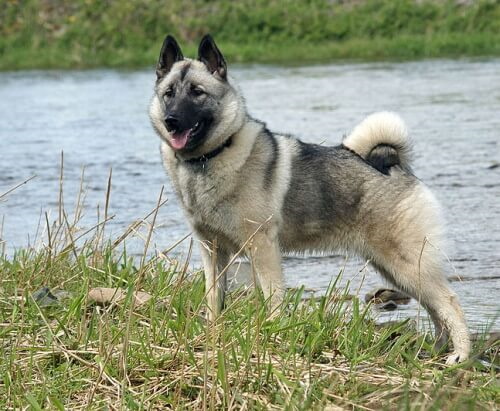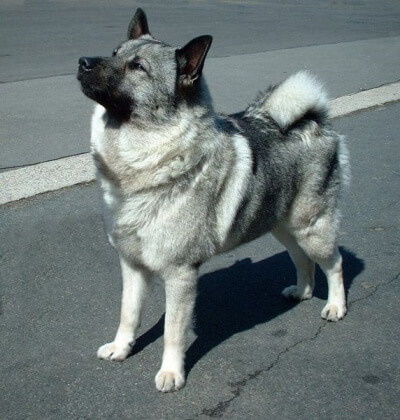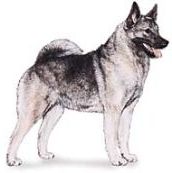Norwegian Elkhound
Brave and Gentle!
The Norwegian Elkhound is considered to be reliable, loyal and friendly and will make friends with all members of the family. Although they are hardy enough to live outside, they prefer to be an inside dog where they can interact with their human pack.
 Courtesy D.Guskov
Courtesy D.GuskovWhen it comes to training, owners should utilize positive reinforcement
methods along with creativity and patience. Stay away from long, drawn
out repetitive drills as this will just get your very intelligent
Elkhound yawning and distracted.
Although this breed has an independent streak, with carefully
constructed training and a gentle approach, they will learn anything
quite easily.
They are keenly aware of their surroundings and make good watchdogs.
History of the Norwegian Elkhound
Historically, the Norwegian Elkhound dates back to Viking times, or about six thousand years ago. They are known for their hunting prowess and great courage, working in very harsh and cold terrain, going up against the large Moose, as well as lynx, bears and wolves.
They were also used as sled dogs, for herding, and as an excellent
watchdog around the family farm.
This beautiful and sturdy looking dog is also known as the Norsk Elghund, which
translated means Norwegian Moose Dog.
The Elkhound, though generally classified with the hound dog breeds,
doesn't actually have any hound genes, but likely has some connection
with Spitz breed lines.
It may come as no surprise, that this very handsome breed is the
National Dog Of Norway. With tons of stamina and a gentle nature, they
are tough yet mild mannered and make good family pets.
 Norvin Son of Storm Photo by Sannse.
Norvin Son of Storm Photo by Sannse.
Physical Stats And Care
Height: 18-20 inches
Weight: 48-55 lbs.
Color variations: Double-coated in gray with black tips, although it can
be just gray or black, with the latter being quite rare.
The Elkhound's thick double coat sheds year-round and needs regular
brushing and combing especially during the time of its seasonal heavy
shedding.

Most owners appreciate the little-to-no dog odor of the breed
and that they only need an occasional bath.
Because of his heavy coat, this breed is happier in cooler climates. That being said, it is a also a good idea to
have a professional grooming in the spring before the warm weather sets in and again
in June.
Otherwise this dog may get quite uncomfortable on warm days.
Health Notes
The Norwegian Elkhound can live up to fifteen years with good care. Part
of that care includes keeping an eye on their food intake as they are
one of the breeds more prone to weight gain.
Though generally healthy, some of the health issues that may affect the breed include:
- Hip dysplasia
- Kidney disease such as Fanconi Syndrome
- Potential for eye problems such as PRA, cataracts, glaucoma etc.
Recent studies conducted by the University of Helsinki, published in September 2013, have revealed a gene mutation that can affect this breed.
When present, the mutated gene causes chondrodysplasia (dwarfism) in the Norwegian Elkhound and one other breed - the Karelian Bear Dog.
On a positive note, a test is now available to detect carriers of the mutation and hopefully this will assist in breeding it out of future generations. More information on the research can be found here: sciencecodex.com

How Active is the Norwegian Elkhound?
This is quite an energetic dog both indoors and out and does best with a fair amount of daily exercise. If someone in the
family likes to jog, he will be glad to go along.
One caution is for owners to be diligent during warm weather that this dog does not
overheat.
Ideal Living Space?
The Norwegian Elkhound can adapt to an apartment or house, but a house with yard and room to run is preferred. Otherwise,
significant daily exercise is needed.
Secure fencing of the outdoor area is a must due to his strong hunting instincts
plus his talent for digging.
As mentioned previously, they are best suited to cooler climates - need not be as extreme as the ones in which they originated,
but areas which experience high heat would definitely not be ideal!
Does the NE Do Well With Children?
This breed is an affectionate and protective family companion but does best with older children who have previously interacted with high energy dogs.
As always, no matter what the breed of dog, caution and supervision is recommended whenever children are interacting with pets.
Senior Or Less Active Families?
While the Norwegian Elkhound can be a dependable and loyal dog for seniors or the less active, it's not a suitable dog for first time dog owners.
Another big consideration is that he needs a lot of exercise and someone in the family circle would need to reliably handle this on a daily basis.
Further Reading

Covers breed history and characteristics, behavior, puppy selection, feeding, training, and preventative health care. Also has advice about preparing for a new puppy, house-training and preventing puppy problems. Lots of color photos.
Image: Sannse, CC BY-SA 3.0 via Wikimedia Commons


